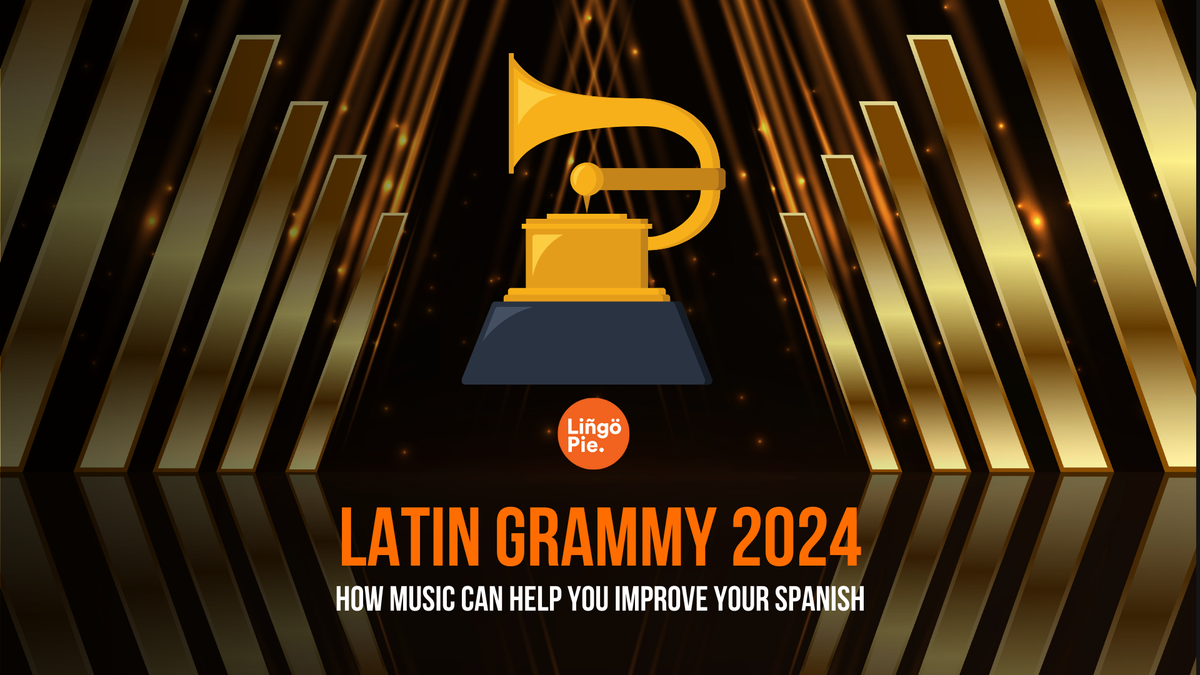They say that music is the universal language, and I believe it’s true. Music has the power to connect us with people and cultures we might otherwise never experience. I remember when I was a teenager, one of the main reasons I kept learning English was my love of music. I wanted to understand the lyrics of my favorite artists, to feel the words as much as the melody. Maybe you feel the same way about Latin music—that pull to not only hear it but to understand and connect with the language.
If you’re a fan of Latin music, the Latin Grammy celebrates the best in Spanish-language music. Beyond being a great show, it also gives Spanish learners a chance to get a feel for the language. With artists from all over the Spanish-speaking world—from reggaeton stars to salsa legends—this year’s Latin Grammys could be the perfect soundtrack for Spanish learning. In this article, we’ll explore how the 2024 Latin Grammy music can help you improve your Spanish skills, from boosting your vocabulary to fine-tuning your pronunciation.

What Are The Latin Grammy Awards?
Did you know that the Latin Grammy Awards are one of the biggest celebrations of Spanish-speaking music in the world? Since they kicked off in 2000, the Latin Grammys have done more than hand out trophies—they have shed light on the incredible diversity of Latin music. Unlike the mainstream Grammys, where English is the focus, the Latin Grammys are all about Spanish—and Portuguese-language music, covering everything from reggaeton and salsa to Latin pop and regional Mexican sounds.
The Latin Grammy 2024 is set to showcase the latest and greatest in Latin music, bringing together artists from across Latin America, Spain, and beyond. However, it is much more than just music— it is a celebration of culture, language, and the fascinating stories that make up Spanish-speaking communities around the globe. So, if you’re learning Spanish, watching the Latin Grammys is a chance to fully engage with the language and get a taste of the music that Spanish speakers live and breathe every day.
Benefits Of Using Music For LanguageLearning
Using music to learn Spanish is one of the best ways to make the language stick. Why? Because music has rhythm and repetition that makes words easier to remember, plus it comes packed with emotion and context. That makes sense, right? Here are a few reasons why learning Spanish with music works:
Real Vocabulary And Expressions
When you listen to a song, you’re getting real words and phrases that people actually use. It’s a step away from textbook language and a step closer to how people really speak. Songs are filled with everyday language, slang, and cultural expressions, so you’re not only picking up Spanish, but you’re learning how to talk like natives do.
Better Pronunciation, Just By Singing Along
Ever noticed how singing along to a song makes you mimic the way the artist pronounces each word? That’s because, with music, you can naturally hear and repeat the way words are meant to sound. It’s one of the easiest ways to get a feel for pronunciation and intonation without feeling like you’re in a classroom.
Accents And Dialects From Different Countries
Spanish varies widely depending on where it’s spoken. Argentine Spanish sounds different from Colombian Spanish, and Mexican Spanish has its own style. By listening to artists from all over the Spanish-speaking world, you get to hear these differences firsthand. Not only does it make you more versatile in Spanish, but it also gives you a richer understanding of the cultures that come with each accent.
Sticking Power Through Catchy Tunes
Songs have a way of getting stuck in our heads, whether we want them to or not! This is perfect for language learning because those catchy tunes keep the words on repeat in your mind. You might find yourself humming a line, only to realize you’re practicing Spanish vocabulary at the same time. It’s a natural, low-effort way to reinforce what you’ve learned.
Cultural Connection
Music gives you an inside look at the cultures and stories behind the language. When you listen to Latin Grammy artists, for example, you’re not just hearing Spanish; you’re hearing the sounds, stories, and experiences of people from different Spanish-speaking communities. This can make learning Spanish feel more personal and inspiring.
How To Use Music To Boost Your Spanish
Music is a great way to boost your Spanish skills and a lot more fun than traditional study methods. Here’s how you can turn your favorite songs into a powerful learning tool:
1. Listen First, Sing Later
Start by just listening to the song. Don’t worry about trying to understand every single word right away. Focus on getting the feel of the song, the rhythm, and the flow. As you listen, try to pick out any familiar words or phrases. This gives your brain a chance to start connecting sounds with meaning before diving deeper into the lyrics.
2. Read And Follow Along With The Lyrics
Once you’re familiar with the song, find the lyrics online (many sites offer them in both Spanish and English). Follow along with the song while reading the words. This is where you can start making connections between what you’re hearing and the written words. You’ll pick up new vocabulary, and it’ll help you understand how words are pronounced in real-life contexts.
3. Translate The Lyrics
A great way to really dig into a song is by translating the lyrics. Start with lines you don’t understand and try to figure them out. This helps build your vocabulary and gives you a deeper understanding of sentence structure. If you get stuck, look up the meaning of specific words or phrases. Don’t be afraid to use a translation tool—it’s all part of the learning process.
4. Sing Along For Pronunciation Practice
Once you've gotten the hang of the lyrics, try singing along. Singing helps improve your pronunciation because it forces you to mimic the exact rhythm and pronunciation of the artist. You’ll get a sense of how certain sounds should flow, and it’s a fun way to practice without feeling like you’re “studying.” Plus, it's a great way to remember tricky words or phrases.
5. Focus On The Vocabulary
Every time you hear a word or phrase you don’t know, take a moment to write it down. Afterward, look it up, add it to your vocabulary list, and review it later. You can even group the words by themes—like emotions, travel, or relationships—so you can focus on one topic at a time. With music, you’re naturally exposed to a variety of vocabulary, much of which may come up in everyday conversation.
6. Use Music Videos To Learn More
Watching the music video while listening to the song can give you a visual context for the lyrics. It’s a fun way to connect words to actions or emotions, which makes them easier to remember. Plus, many artists use body language or cultural references in their videos, which can give you insight into the meanings behind the lyrics.
Learn Spanish Through Music With Lingopie!
In this article, we’ve explored how music can be used as a language-learning tool. And with the Latin Grammy Awards just around the corner, you can use your favorite songs from the event as your guide. You can pick up real-life vocabulary, practice pronunciation, and experience the different accents and cultures of the Spanish-speaking world. Whether you’re following along with lyrics, building a vocabulary list, or exploring genres like reggaeton, salsa, and pop, music makes language learning feel more intuitive.
For even more ways to practice, check out Lingopie! It’s a fantastic platform offering Spanish shows, movies, and music-based content, giving you a real-world language experience right at your fingertips.





